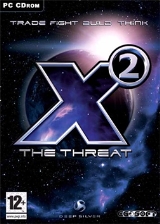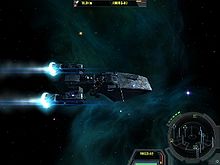
X²: The Threat
Encyclopedia
X²: The Threat is a computer game developed by Egosoft
for Windows
, Linux
, and Mac OS X
. It is part of the X Computer Game Series. It was released in 2003
and is a sequel to X: Beyond the Frontier
. Freeverse Software
ported
the game to Mac OS X
in 2004/2005, while Linux Game Publishing
produced their Linux
port in 2005/2006.
The sequel to this game is X3: Reunion (2005).
 As with the originals, X2: The Threat is a Space trading and combat simulator set in the fictional X-Universe, a network of sectors, linked by large space gates. The game features a new graphics engine
As with the originals, X2: The Threat is a Space trading and combat simulator set in the fictional X-Universe, a network of sectors, linked by large space gates. The game features a new graphics engine
, a much expanded Universe and 60 different flyable ships, along with a number of new missions available to the player. Unlike the expansion pack, X-Tension, which was almost entirely open-ended, X2: The Threat has a clear background story involving an aggressive alien race known as the Khaak. However, the game remains open-ended and the players are free to pursue the plot at their own pace, if at all.
X2: The Threat was generally well received by critics, with many reviewers praising the graphics and the amount of freedom offered to the player. Common complaints were that X2: The Threat, like its predecessors, was quite slow paced and had a steep learning curve
.
Key non-player characters include:
Due to the expense of completing the plot, the players are periodically prompted to break away from the plot and increase their resources through trade and other open-ended play.

Using credits, a player can buy wares from a station. These wares may then be flown to another station where they can be sold, ideally for a higher price. However, prices vary - from minute to minute, second to second - depending on demand. The less of a ware there is, the higher its price. As such, the X-Universe has a truly dynamic market-driven economy
. A player can capitalize on emergent
trends to make vast profits; or as easily, can waste money and time on a bad cargo choice. As a player builds profits they can buy equipment, weapons, ships and stations. The player can acquire an unlimited number of ships and stations, of varying size, shape and function. The player can build factories to produce goods (including weapons and shields) to sell or consume. As the factories require resources, the player can set up ships to perform trading tasks for factories such as buying resources from other stations or selling the product.
The game contains numerous races. Several races feature a full economy and can be interacted with by the player through trading, reputation and missions. Several hostile races limit the amount of interactivity to combat. Reputation between the player and the social races can be built up through missions, defending their space, or trading in their space. The reputation affects how these individuals of that races respond to the player, and what kind of missions are offered. A player status is categorized according to 'Mercantile' skill, 'Combat' skill, and a 'Notoriety' ranking for each race.
Egosoft
Egosoft is a computer game developer founded in 1988 and based in Würselen, Germany. It became a commercial company in 1990. Its first products were for the Amiga, but it later became a PC game developer....
for Windows
Microsoft Windows
Microsoft Windows is a series of operating systems produced by Microsoft.Microsoft introduced an operating environment named Windows on November 20, 1985 as an add-on to MS-DOS in response to the growing interest in graphical user interfaces . Microsoft Windows came to dominate the world's personal...
, Linux
Linux
Linux is a Unix-like computer operating system assembled under the model of free and open source software development and distribution. The defining component of any Linux system is the Linux kernel, an operating system kernel first released October 5, 1991 by Linus Torvalds...
, and Mac OS X
Mac OS X
Mac OS X is a series of Unix-based operating systems and graphical user interfaces developed, marketed, and sold by Apple Inc. Since 2002, has been included with all new Macintosh computer systems...
. It is part of the X Computer Game Series. It was released in 2003
2003 in video gaming
-Events:*February 27 — Academy of Interactive Arts & Sciences hosts 6th Annual Interactive Achievement Awards; inducts Yu Suzuki of Sega to the AIAS Hall of Fame....
and is a sequel to X: Beyond the Frontier
X: Beyond the Frontier
X-Tension was released as an expansion to X:BTF; however, many gamers and reviewers consider it more a "sequel" than an "add-on". It follows on after the story in X: BTF, with "the evil Xenon vanquished" and the player "still stranded light years from home." The player once again takes control of...
. Freeverse Software
Freeverse Software
Freeverse Inc. is a computer and video game, and desktop software developer owned by Ngmoco. Based in New York City, Freeverse titles received numerous awards including a Macworld Game Hall of Fame, two Macworld San Francisco Best of Shows and three Apple Design Awards in 2004...
ported
Porting
In computer science, porting is the process of adapting software so that an executable program can be created for a computing environment that is different from the one for which it was originally designed...
the game to Mac OS X
Mac OS X
Mac OS X is a series of Unix-based operating systems and graphical user interfaces developed, marketed, and sold by Apple Inc. Since 2002, has been included with all new Macintosh computer systems...
in 2004/2005, while Linux Game Publishing
Linux Game Publishing
Linux Game Publishing is a software company based in Nottingham in England. It ports, publishes and sells video games running on Linux operating systems. As well as porting games, LGP also sponsors the development of Grapple, a free software network library for games...
produced their Linux
Linux
Linux is a Unix-like computer operating system assembled under the model of free and open source software development and distribution. The defining component of any Linux system is the Linux kernel, an operating system kernel first released October 5, 1991 by Linus Torvalds...
port in 2005/2006.
The sequel to this game is X3: Reunion (2005).
Gameplay

Game engine
A game engine is a system designed for the creation and development of video games. There are many game engines that are designed to work on video game consoles and personal computers...
, a much expanded Universe and 60 different flyable ships, along with a number of new missions available to the player. Unlike the expansion pack, X-Tension, which was almost entirely open-ended, X2: The Threat has a clear background story involving an aggressive alien race known as the Khaak. However, the game remains open-ended and the players are free to pursue the plot at their own pace, if at all.
X2: The Threat was generally well received by critics, with many reviewers praising the graphics and the amount of freedom offered to the player. Common complaints were that X2: The Threat, like its predecessors, was quite slow paced and had a steep learning curve
Learning curve
A learning curve is a graphical representation of the changing rate of learning for a given activity or tool. Typically, the increase in retention of information is sharpest after the initial attempts, and then gradually evens out, meaning that less and less new information is retained after each...
.
Plot
The player takes the role of Julian Gardna, a Pirate and thief. Early on, the Khaak, a hostile alien race, emerge to threaten the X-Universe. The player is asked to undertake a series of missions to uncover their origins, their intentions, and to determine their connection to his missing father. Ultimately, Julian must fight off a massive attack by Khaak, rescuing numerous other characters in the process.Key non-player characters include:
- Bret Serra: rogue, pirate and Julian's closest friend;
- Ban Danna: the head of Argon Secret ServiceSecret serviceA secret service describes a government agency, or the activities of a government agency, concerned with the gathering of intelligence data. The tasks and powers of a secret service can vary greatly from one country to another. For instance, a country may establish a secret service which has some...
who shares a close relationship with Julian's father dating back to the previous game, X: Beyond the FrontierX: Beyond the FrontierX-Tension was released as an expansion to X:BTF; however, many gamers and reviewers consider it more a "sequel" than an "add-on". It follows on after the story in X: BTF, with "the evil Xenon vanquished" and the player "still stranded light years from home." The player once again takes control of...
; - Elena Kho, Chief Executive in the influential Terracorp corporation;
- Saya Kho, daughter of Elena Kho;
- Kyle Brennan, Julian's father, founder of Terracorp, and protagonist from the previous games.
Due to the expense of completing the plot, the players are periodically prompted to break away from the plot and increase their resources through trade and other open-ended play.

Open Ended
X2 is set within the X-Universe, which consists of 130 sectors connected by two-way jumpgates. The main area of each sector typically contains several stations and at least one gate. The game is open-ended allowing the player to go where they like, when they like, doing whatever they like; a player is limited only by their in-game status and resources. As such, a driving force of the game is to acquire credits, the universal currency and status.Using credits, a player can buy wares from a station. These wares may then be flown to another station where they can be sold, ideally for a higher price. However, prices vary - from minute to minute, second to second - depending on demand. The less of a ware there is, the higher its price. As such, the X-Universe has a truly dynamic market-driven economy
Market economy
A market economy is an economy in which the prices of goods and services are determined in a free price system. This is often contrasted with a state-directed or planned economy. Market economies can range from hypothetically pure laissez-faire variants to an assortment of real-world mixed...
. A player can capitalize on emergent
Emergence
In philosophy, systems theory, science, and art, emergence is the way complex systems and patterns arise out of a multiplicity of relatively simple interactions. Emergence is central to the theories of integrative levels and of complex systems....
trends to make vast profits; or as easily, can waste money and time on a bad cargo choice. As a player builds profits they can buy equipment, weapons, ships and stations. The player can acquire an unlimited number of ships and stations, of varying size, shape and function. The player can build factories to produce goods (including weapons and shields) to sell or consume. As the factories require resources, the player can set up ships to perform trading tasks for factories such as buying resources from other stations or selling the product.
The game contains numerous races. Several races feature a full economy and can be interacted with by the player through trading, reputation and missions. Several hostile races limit the amount of interactivity to combat. Reputation between the player and the social races can be built up through missions, defending their space, or trading in their space. The reputation affects how these individuals of that races respond to the player, and what kind of missions are offered. A player status is categorized according to 'Mercantile' skill, 'Combat' skill, and a 'Notoriety' ranking for each race.

